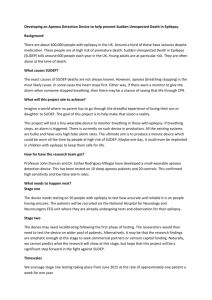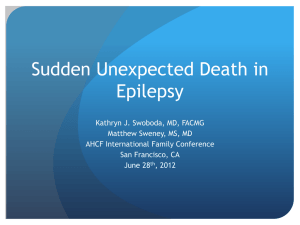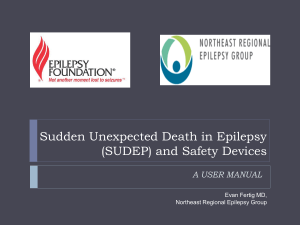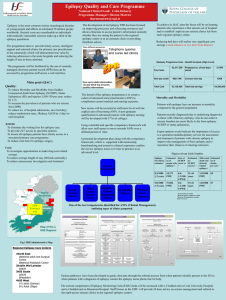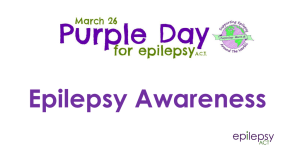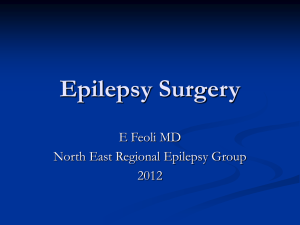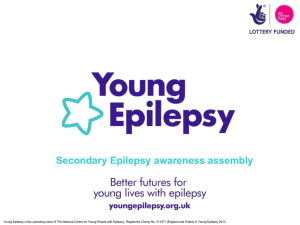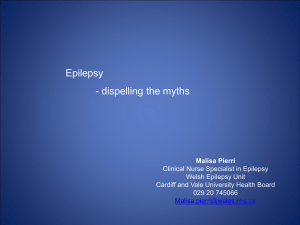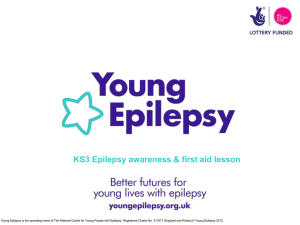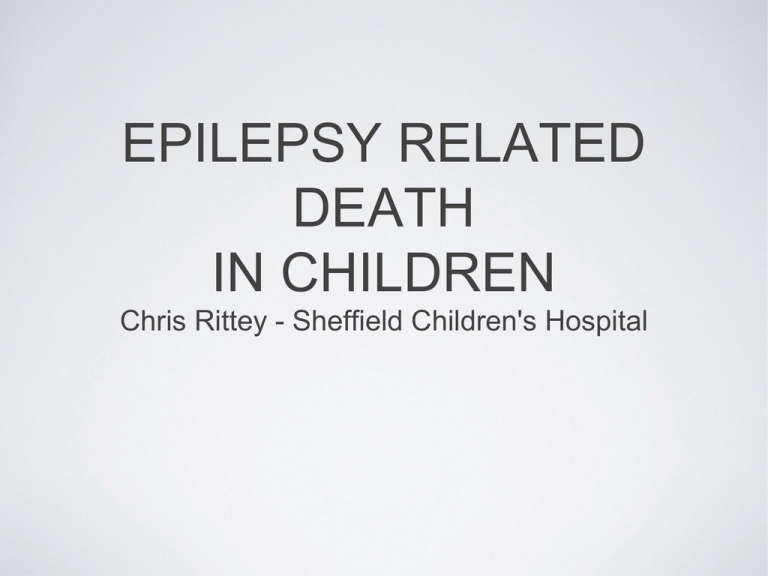
EPILEPSY RELATED
DEATH
IN CHILDREN
Chris Rittey - Sheffield Children's Hospital
Definitions
•
Definite SUDEP
• Patient suffered from epilepsy
• Patient died unexpectedly in reasonable health
• Death occurred suddenly (where known)
• An obvious medical cause of death was not found
• Death was not the direct result of seizure or SE
• Probable SUDEP
• As above but no PM
• Possible SUDEP
• SUDEP cannot be ruled out but insufficient information
Nashef et al, 1997
•
Epidemiology
•
Risk factors
•
Mechanisms
•
Management strategies
•
Providing information
•
Checklist
EPIDEMIOLOGY
•
Incidence much lower in reported series in children
•
Rates fairly consistent across studies in UK, Europe
and USA
•
Main issue remains ascertainment
Incidence
Epilepsy related deaths
Harvey et al 1993
6.6/10000 patient years
Donner et al 2001
2/10000 (SUDEP)
Callenbach et al 2001
3.8/1000 (all deaths)
Camfield & Camfield 2002 2.8/1000
Weber et al 2005
4.3/10000 (SUDEP)
McGregor et al 2006
17 over 12 years (11 <19
years) – 7 def, 9 prob
Nickels et al 2012
4.4/10000 (SUDEP 2.2)
Camfield & Camfield
•
Population based cohort study
•
All children who developed epilepsy in
Nova Scotia (1977-1985) – population
850000
•
692 children – 26 deaths
Only 4 unexpected deaths – 2 epilepsy
related, 1 SUDEP (21 year old woman)
•
Lancet 2002, 359: 1891-95
Callenbach et al
•
Dutch epilepsy study group
1988-1992 – all children with epilepsy (<
16 years) – 494 children (22 excluded)
•
•
5 year follow-up or to death
•
9 deaths – no SUDEP
Pediatrics 2001; 107: 1259-63
Nesbitt et al
•
Retrospective UK review from tertiary
paediatric neurology service (97
deaths)/CEMACH (168 deaths)
•
Neurology cohort - 66% deaths unrelated to
seizure disorder, 7 unexplained deaths (7.3%)
CEMACH cohort – 79% unrelated to seizure
disorder, 25 unexplained (9.7%)
•
Dev Med Child Neurol 2012; 54: 612-17
Risk factors for SUDEP
•
Majority of cases of SUDEP in adults had childhood
onset epilepsy
• Most deaths occur in sleep
• Risks for childhood SUDEP include
• Male sex
• Symptomatic epilepsy
• GTCS
• Prone sleep posture (?)
• Risks not identified
• Low AED levels, polypharmacy, specific AEDs
SUDEP in adults
•
Risks identified:
• GTCS
• Polypharmacy
• Duration of epilepsy
• Young age at onset of epilepsy
• Male gender
• Symptomatic epilepsy
• Lamotrigine therapy
• Lack of terminal remission
Hesdorfer et al, Epilepsia 2011; 52: 1150-59
Idiopathic epilepsy
•
Extremely low risk of epilepsy related
death and SUDEP in children with idiopathic
epilepsy
•
Very rare reports of epilepsy related
deaths in children with idiopathic epilepsy
•
Nesbitt et al suggest risk of 65/100000 (cf
diabetes 45/100000)
Causes of death
In childhood majority of deaths unrelated to
seizure disorder (i.e. due to underlying
condition or co-morbidities)
Sillanpaa & Shinnar
•
Long term follow-up of childhood onset
epilepsy - 245 children, 40 years, 60 deaths
•
33/60 epilepsy related deaths
•
23/60 SUDEP (8 < 19 years)
•
4/60 status epilepticus (2 < 19 years)
•
6/60 drowning (3 < 19 years)
Epilepsy & Behaviour 2013; 28: 249-55
Mechanisms of SUDEP
•
SUDEP is likely to be the consequence of
a variety of processes
•
Likely mechanisms
–
respiratory
–
cardiac
–
‘electrocerebral shutdown’
Respiratory mechanisms
•
Most witnessed cases occur with GTCS
•
Most reported cases had difficulty with
breathing
•
Apnoea a frequent finding in VT recorded
seizures
•
Likely that central and obstructive apnoea
plays a role
Respiratory mechanisms
•
Several postulated mechanisms
– Respiratory arrest
– Neurogenic pulmonary oedema
– Asphyxiation
• Recent interest in 5HT defects in SUDEP
(Richerson and Buchanan, Epilepsia 2011)
– mouse models
– 5HT role in control of breathing
– common pathway with SIDS
Cardiac mechanisms
•
•
Most important mechanism likely to be cardiac
dysrhythmia caused by seizure
–
bradyarrhythmia
–
ventricular tachyarrhythmias
–
role of long QT syndromes
Right hemispheric control of sympathetic
cardiac control
–
cardiovascular dysregulation common in
children with right temporal lobe seizures
Cardiac mechanisms
•
Possible role of stress induced release of
catecholamines
•
Potential role of environmental stress
possible therapeutic interventions
•
SUDEP reported in people with VNS but
evidence suggests slight reduction of
SUDEP risk in this population
Management
•
I
Almost all witnessed cases of SUDEP are
associated with a seizure
• Reduced SUDEP rate in people undergoing
successful epilepsy surgery
• Phase II trials in adults suggest increased
mortality and SUDEP in those randomised to
placebo
• Suggests causal relationship between seizure
and SUDEP
Management
•
II
Aim for seizure freedom
•
Suggestion that where this cannot be achieved
aggressive attempts at seizure control can
reduce but not eliminate risk of SUDEP
•
Careful attention to basic safety precautions
(bathing, swimming)
Pet ownership (?) – see Terra et al, Seizure
2012; 21: 649-51
•
What do we tell our patients?
•
SUDEP is a risk for patients with epilepsy
not in remission
•
In neurologically normal children risk is not
significant until adolescence/adulthood
•
? Need to discuss at all with families of
children with idiopathic epilepsy likely to
remit in childhood (e.g. BCECTS)
Gayatri et al
•
Questionnaires to parents attending regional
paediatric neurology service and to 71 UK
paediatric neurologists
• Parental questionnaire – repeated after 3
months
• 100 children (57 focal/epileptic
encephalopathy)
• 1/3 had heard of SUDEP before the study
• 91% wanted to be told about SUDEP (74% at
diagnosis, 16% when seizures poorly controlled)
Gayatri et al
•
Majority of parents reported no adverse effects of
being given SUDEP information
• Approx 50% said they would alter care for their child
following information
•Neurologist questionnaire – 46 responses
• 43/46 (93%) provided SUDEP information
• 20% - to all patients
• 63% - to patients with intractable seizure
• 46% - to parents and children (> 12 years)
SUDEP checklist
•
Several risk factors for SUDEP are
potentially modifiable
•Shankar
et al suggest use of evidence
based checklist may allow clinicians and
patients to identify and act on these
•
Potential benefit in improving discussion
about epilepsy related death
Seizure 2013 – in press
Conclusions
Children with epilepsy have a 3-4 x
increase risk of death than the general
population
• Most deaths in children with epilepsy are
not related to the seizure disorder
• Death may occur as a result of SE,
accident and SUDEP
•
Conclusions
•
SUDEP risks are extremely low in children but
finite risk in those with poorly controlled
symptomatic epilepsies
• Strategies directed towards optimal seizure
control likely to be most useful in reducing
SUDEP rate
• Parents want to be told about SUDEP
• Checklist may be of value but will probably
need modification in childhood

